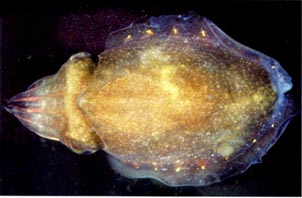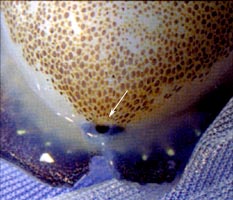Sepiella
Katharina M. Mangold (1922-2003) and Richard E. Young- Sepiella ornata
- Sepiella cyanea
- Sepiella inermis
- Sepiella japonica
- Sepiella ocellata
- Sepiella weberi
Introduction
The most distinctive feature of the genus is the presence of a large subcutaneous gland that opens by a pore at the posterior end of the mantle between the fins.
Brief diagnosis:
A sepiid ...
- with a pore posteriorly between fins.
Characteristics
- Funnel
- Funnel component of locking apparatus with pit-like depression at midpoint of groove.
- Mantle
- Duct from large gland beneath skin on posterodorsal mantle opens posteriorly between fins.
- Shell
- Cuttlebone length approximately equal to mantle length.
- Cuttlebone with posterior spine between fins absent.
Comments
The function of the secretion from the posterior gland is unknown.
References
Adam, W. and W. J. Rees. 1966. A review of the cephalopod family Sepiidae. Sci. Rep. John Murray Exped. 11: 1-165.
Khromov, D. N., C. C. Lu, A. Guerra, Zh. Dong and S. v. Boletzky. 1998. A synopsis of Sepiidae outside Australian waters. Smithson. Contr. Zool., 586: 77-156.
Lu, C. C. A synopsis of Sepiidae in Australian waters. 1998. Smithson. Contr. Zool., 586:159-190.
Roeleveld, M.A. 1972. A Review of the Sepiidae (Cephalopoda) of Southern Africa. Annals of the South African Museum, 59(10):193-313.
Title Illustrations

| Scientific Name | Sepiella inermis |
|---|---|
| Location | Singapore |
| Specimen Condition | Live Specimen |
| View | Dorsal |
| Size | 130 mm ML |
| Copyright | © 2004 Mark Norman |
About This Page
Katharina M. Mangold (1922-2003)

Laboratoire Arago, Banyuls-Sur-Mer, France

University of Hawaii, Honolulu, HI, USA
Page copyright © 2016 Katharina M. Mangold (1922-2003) and
 Page: Tree of Life
Sepiella .
Authored by
Katharina M. Mangold (1922-2003) and Richard E. Young.
The TEXT of this page is licensed under the
Creative Commons Attribution-NonCommercial License - Version 3.0. Note that images and other media
featured on this page are each governed by their own license, and they may or may not be available
for reuse. Click on an image or a media link to access the media data window, which provides the
relevant licensing information. For the general terms and conditions of ToL material reuse and
redistribution, please see the Tree of Life Copyright
Policies.
Page: Tree of Life
Sepiella .
Authored by
Katharina M. Mangold (1922-2003) and Richard E. Young.
The TEXT of this page is licensed under the
Creative Commons Attribution-NonCommercial License - Version 3.0. Note that images and other media
featured on this page are each governed by their own license, and they may or may not be available
for reuse. Click on an image or a media link to access the media data window, which provides the
relevant licensing information. For the general terms and conditions of ToL material reuse and
redistribution, please see the Tree of Life Copyright
Policies.
- Content changed 21 April 2008
Citing this page:
Mangold (1922-2003), Katharina M. and Richard E. Young. 2008. Sepiella . Version 21 April 2008 (under construction). http://tolweb.org/Sepiella/20010/2008.04.21 in The Tree of Life Web Project, http://tolweb.org/











 Go to quick links
Go to quick search
Go to navigation for this section of the ToL site
Go to detailed links for the ToL site
Go to quick links
Go to quick search
Go to navigation for this section of the ToL site
Go to detailed links for the ToL site